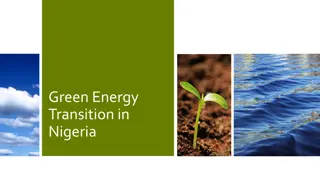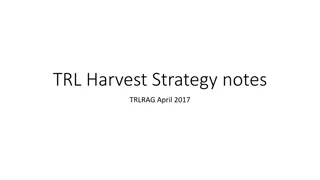Sustainable Energy Proposal for Biomass Utilization in Costa Rica
Costa Rica's NAMA Energy/Biomass proposal aims to support the energy sector by promoting the use of organic agricultural and forestry residues for clean energy production. The project focuses on optimizing value chains, improving energy efficiency, developing monitoring systems, incorporating environmental labels, and promoting financing schemes in alignment with the country's policy frameworks for renewable energy and climate change mitigation.
Download Presentation

Please find below an Image/Link to download the presentation.
The content on the website is provided AS IS for your information and personal use only. It may not be sold, licensed, or shared on other websites without obtaining consent from the author. Download presentation by click this link. If you encounter any issues during the download, it is possible that the publisher has removed the file from their server.
E N D
Presentation Transcript
NAMA Energy/Biomass - Costa Rica NAMA Proposal Group - Roundtable September 2015 With support from:
Executive Resume Country : Costa Rica Project: Support project for the energy sector in Costa Rica Implementation: MINAE-DCC/ICE/MAG) Mitigation, adaptation, energy efficiency, emission reduction and resiliency model under climate change Working areas: Support partners: Spaniard Cooperation - AECID German Development Cooperation - GIZ Direct beneficiaries: Electrical and thermal users switching in the energy matrix Stakeholders: Private companies, Cooperatives and ICE.
Technical areas: Dry biomass residues Wet biomass residues Organic agricultural residues Focus: Sugar cane, Pineapple, Rice, Palm oil, Bananas, Wood and Livestock (not limited )
Objective Facilitate the use of organic agricultural/forestry residues available with the best economically attractive technologies (BEAT) to increase the use of clean energy towards a low emission development path.
Specific objectives Component 1: Promote best practices at the farm level in order to optimize the value chain in high potential activities. Component 2: Improve the energy efficiency and energy production systems (thermal and electrical) in agroindustry as an opportunity to lower the product emissions. Component 3: Develop an MRV system for the components 1 and 2.
Specific objectives Component 4: Incorporate product environmental labels for present and future markets. Component 5: Promote financing schemes for the transformation of new business models with local and regional partners (private and public banks).
Enabling framework Policy framework: National Development Plan 2015-2018 VI National Energy Plan 2012-2030 (MINAE-DSE) Biofuels Law (Proposal) No.18789. V Non-Conventional Renewable Sources Plan (ICE) VI Expansion Plan (ICE) National Climate Change Strategy (MINAE-DCC) Convention Ratification: Law N 8219 Kyoto Protocol Law N 7414 Climate Change Framework Costa Rica National Constitution: Article 50 Others
Development steps Success factors MRV requirements 10 steps to a NAMA 10. Good practices 9. Implement and MRV 8. Send NAMAs to the registry NAMA design 7. Support needs identification 6. Detail the NAMA planning 6. Detail the NAMA planning 5. Design an MRV plan 5. Design an MRV plan 4. Define a baseline 4. Define a baseline 3. Identify the potential NAMAs 3. Identify the potential NAMAs LEDS context 2. Evaluate the technical potential for emission reductions and co-benefits 2. Evaluate the technical potential for emission reductions and co-benefits 1. Evaluate the policy gaps, framework conditions and identify required actions 1. Evaluate the policy gaps, framework conditions and identify required actions Siglas
Identification of barriers Financing: Low involvement of the Development Bank initiative regarding low emissions production, transformation or retrofit. Tariff implementation challenge with ARESEP. Information and knowledge management: Technology transfer and development are limited and not widely applied within the sector. Unexpected potential from COMEX and PROCOMER on eco- labelling and the upcoming requirements in the EU (e.g. PEF)
Some barriers Technical assistance: Lack of specialized services (e.g. laboratories) Capacity building needed on the productive uses of organic agricultural residues. Little knowledge of productive associative benefits Low awareness on processes to measure the carbon footprint (e.g. products) Otros...
Dry biomass mitigation potential Boiler fuel switching
Dry biomass mitigation potential Wood residues Tabla 3.10 Resumen del potencial de sustituci n de calderas
Dry biomass mitigation potential Wood residues With an average use of 50% per year and 50% load Accounting 20% of the boilers registered Savings switching from bunker to pellets 12% Displacing fossil fuel with a CO2potential mitigation of 90,415 Kg/hr For a total mitigation of 247,500 t CO2 per year
MRV System ISO/DIS 13065 Sustainability criteria for bioenergy The production and use of bioenergy have potential roles in mitigating climate change, promoting energy security and fostering sustainable development. Virtually every country in the world uses some form of bioenergy. Various types of biomass are used for the production of bioenergy through many types and sizes of economic operations. The characteristics of bioenergy production therefore are heterogeneous and depend on several factors, such as geographic location, climatic conditions, level of development, institutional frameworks and technological issues.
MRV System 6.6 Functional and delivered units Functional units are used as reference units to quantify the performance of a product system. A system can have a number of possible functions; functional unit(s) selection depends on the goal and scope of the GHG assessment. Examples of functional units: 1 kWh of electricity provided by a power plant to the grid Delivered units may be used when reporting a partial carbon footprint. Examples of delivered units are: Volume of liquid bioenergy Mass of pellets GHG emissions should also be reported on the basis of 1 MJ of energy delivered.
Product GHG emissions ISO/TS 14067 Greenhouse gases Carbon footprint of products Requirements and guidelines for quantification and communication Include the bioenergy contribution to the mitigation of final agricultural and livestock products GHG emissions. Check for consumer interest and market sensitivity for low carbon emission products.
Next steps: Obtain the allocation of funds from local and regional banks for investments and match making with international resources in a negotiated ratio Consider the boundaries for a program with international support and the proper synergies with present NAMA initiatives (e.g. NAMA Coffee) Define the steps to have the capacity for product certification with GHG emissions and claims in agricultural and livestock products Develop the final proposal to the interested parties in supporting the initiative (e.g. NAMA FACILITY, EURO CLIMA, AECID among others)
Grupo MESA NAMA Energ a-Biomasa Thank you!!! With support from:
Proceso a realizado 3 Talleres de consulta realizados 1 Encuesta al sector de grandes productores 1 Documento de sistematizaci n de posibles arreglos de las brechas y esquemas tarifarios 20 sesiones de trabajo de la MESA con distintos actores de los sectores























